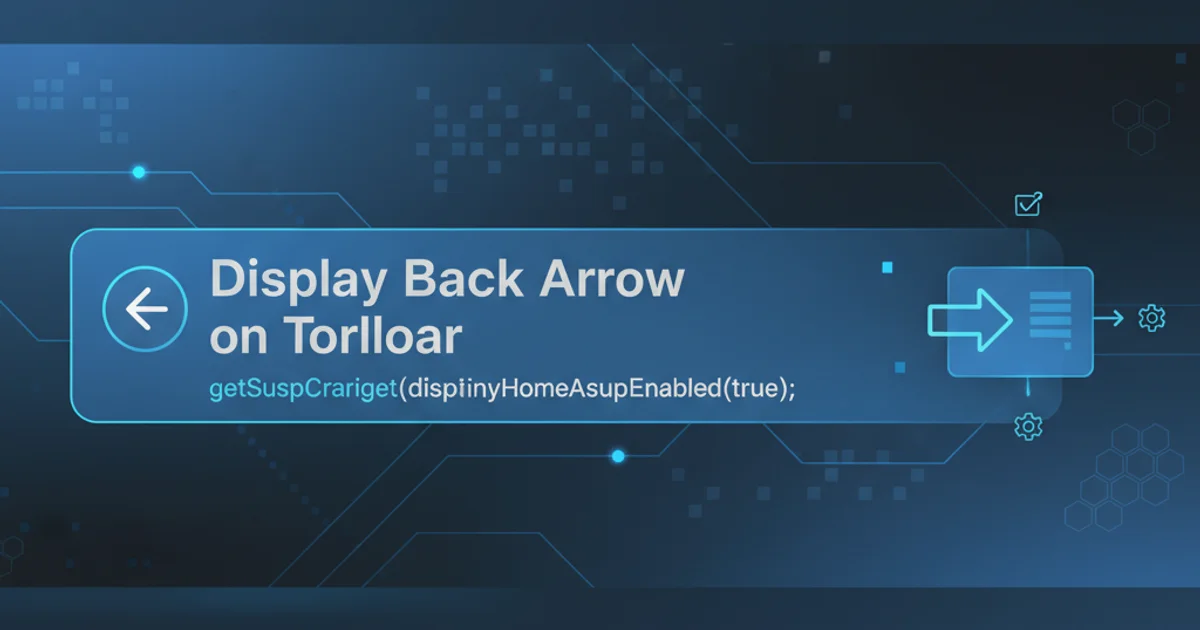Display Back Arrow on Toolbar
Categories:
Implementing a Back Arrow on Your Android Toolbar

Learn how to effectively add and manage a back navigation arrow (Up button) on your Android application's toolbar, enhancing user experience and navigation consistency.
The back arrow, often referred to as the 'Up' button, is a crucial UI element in Android applications. It provides a consistent way for users to navigate hierarchically up the app's navigation stack, typically returning to the previous screen or parent activity. While the system back button handles historical navigation, the Up button provides logical navigation within your app's structure. This article will guide you through the process of implementing and customizing this essential feature using Toolbar and ActionBar (or ActionBarCompat) in your Android projects.
Understanding the Up Button vs. System Back Button
It's important to distinguish between the Up button and the system's back button. The system back button navigates through the user's history of screens, regardless of the app's internal hierarchy. The Up button, conversely, navigates to a specific parent activity defined in your app's manifest or programmatically. This distinction is key for maintaining a predictable and intuitive user experience. For instance, if a user arrives at a detail screen from a search result, the system back button might take them back to the search results, while the Up button would take them to the parent list of items.
flowchart TD
A[User Action] --> B{Navigation Type?}
B -->|System Back Button| C[Goes to previous screen in history]
B -->|Up Button (Back Arrow)| D[Goes to logical parent activity]
C --> E[Can exit app if no history]
D --> F[Stays within app's hierarchy]Comparison of System Back Button vs. Up Button (Back Arrow)
Implementing the Back Arrow with Toolbar
Modern Android development heavily relies on the Toolbar for app bar functionality. To display a back arrow on your Toolbar, you typically need to set it as the ActionBar for your activity and then enable the home as up indicator. This involves a few steps in your activity's onCreate method.
import androidx.appcompat.app.AppCompatActivity;
import androidx.appcompat.widget.Toolbar;
import android.os.Bundle;
import android.view.MenuItem;
public class DetailActivity extends AppCompatActivity {
@Override
protected void onCreate(Bundle savedInstanceState) {
super.onCreate(savedInstanceState);
setContentView(R.layout.activity_detail);
Toolbar toolbar = findViewById(R.id.toolbar);
setSupportActionBar(toolbar);
// Enable the Up button
if (getSupportActionBar() != null) {
getSupportActionBar().setDisplayHomeAsUpEnabled(true);
getSupportActionBar().setDisplayShowHomeEnabled(true);
}
}
@Override
public boolean onOptionsItemSelected(MenuItem item) {
if (item.getItemId() == android.R.id.home) {
// Handle the Up button click
onBackPressed(); // Or navigate to parent activity
return true;
}
return super.onOptionsItemSelected(item);
}
}
Java code to enable the Up button on a Toolbar
<!-- activity_detail.xml -->
<LinearLayout
xmlns:android="http://schemas.android.com/apk/res/android"
xmlns:app="http://schemas.android.com/apk/res-auto"
android:layout_width="match_parent"
android:layout_height="match_parent"
android:orientation="vertical">
<androidx.appcompat.widget.Toolbar
android:id="@+id/toolbar"
android:layout_width="match_parent"
android:layout_height="?attr/actionBarSize"
android:background="?attr/colorPrimary"
app:titleTextColor="@android:color/white" />
<!-- Your activity content goes here -->
</LinearLayout>
XML layout for an activity with a Toolbar
onBackPressed(), you should define the parent activity in your AndroidManifest.xml using the android:parentActivityName attribute or programmatically using NavUtils.navigateUpFromSameTask(this);.Defining Parent Activity in AndroidManifest.xml
To ensure the Up button navigates to the correct parent activity, you can declare the parent-child relationship in your AndroidManifest.xml. This is the recommended approach for simple hierarchical navigation.
<!-- AndroidManifest.xml -->
<application ... >
<activity
android:name=".MainActivity"
android:label="@string/app_name">
<intent-filter>
<action android:name="android.intent.action.MAIN" />
<category android:name="android.intent.category.LAUNCHER" />
</intent-filter>
</activity>
<activity
android:name=".DetailActivity"
android:label="@string/title_activity_detail"
android:parentActivityName=".MainActivity" >
<!-- Parent activity meta-data to support lower API levels -->
<meta-data
android:name="android.support.PARENT_ACTIVITY"
android:value=".MainActivity" />
</activity>
</application>
Defining parent activity in AndroidManifest.xml
android:parentActivityName is defined, calling onBackPressed() from onOptionsItemSelected for android.R.id.home will automatically handle navigation to the parent activity, or you can use NavUtils.navigateUpFromSameTask(this); for more explicit control.1. Step 1: Add Toolbar to Layout
Include a androidx.appcompat.widget.Toolbar in your activity's layout XML file. Ensure it has an id (e.g., @+id/toolbar) and appropriate layout_width and layout_height.
2. Step 2: Set Toolbar as ActionBar
In your activity's onCreate method, find the Toolbar by its ID and call setSupportActionBar(toolbar) to set it as the activity's action bar.
3. Step 3: Enable Up Button
After setting the support action bar, check if getSupportActionBar() is not null, then call setDisplayHomeAsUpEnabled(true) and setDisplayShowHomeEnabled(true) on it to display the back arrow.
4. Step 4: Handle Up Button Clicks
Override the onOptionsItemSelected method in your activity. Check if the selected item's ID is android.R.id.home. Inside this condition, call onBackPressed() or use NavUtils.navigateUpFromSameTask(this) to handle the navigation.
5. Step 5: Define Parent Activity (Optional but Recommended)
For proper hierarchical navigation, declare the parent activity in your AndroidManifest.xml using android:parentActivityName for API 16+ and a <meta-data> tag for older API levels.